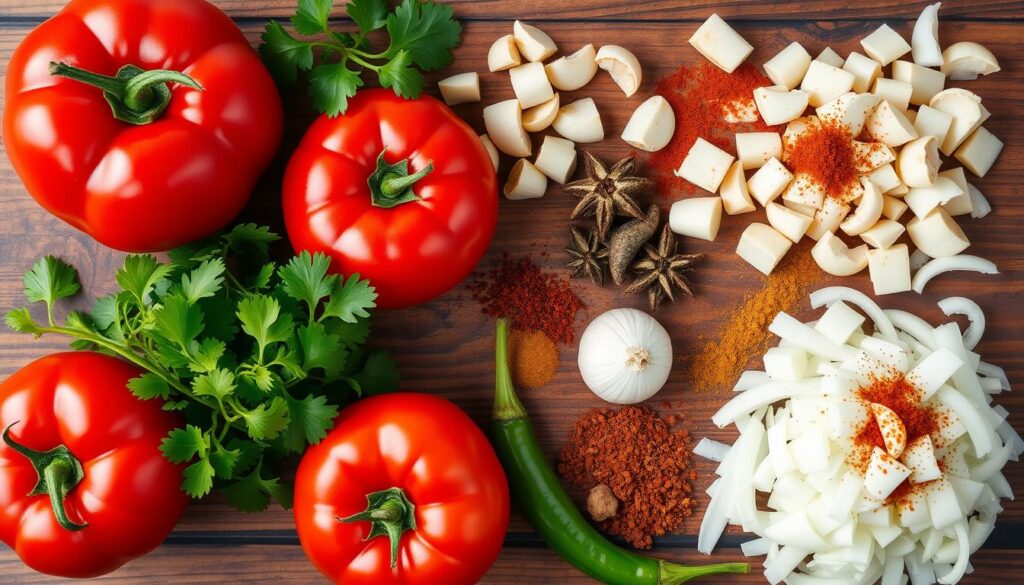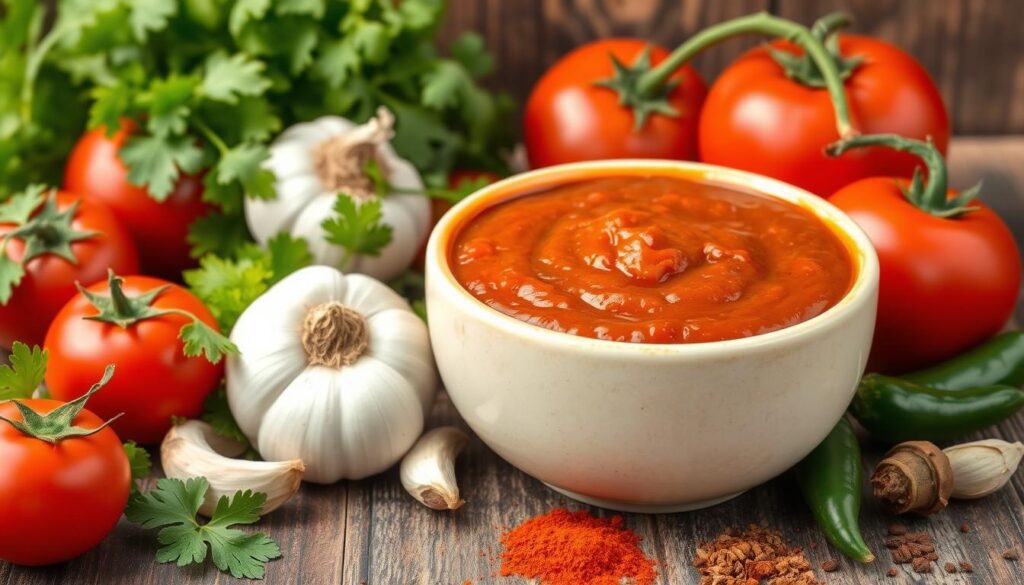Enchilada sauce is a key part of Mexican cuisine, loved for its deep flavor and use in many dishes. It’s not just for enchiladas; it can make any meal better. The mix of ingredients in homemade enchilada sauce creates a unique taste that makes food special. We’ll look at what goes into making this sauce, compare it to store-bought, and share tips for using and keeping it fresh.
Want to make a tasty meal? Try the boulders enchilada recipe for a great start!

Key Takeaways
- Homemade enchilada sauce has a high rating of 4.88 out of 5.
- The recipe yields 56 ounces, equivalent to two standard cans.
- Preparation and cooking time combined is only 20 minutes.
- Each ¼ cup serving contains approximately 41 calories.
- Recipe can be stored in the refrigerator for 4-5 days or frozen for 3-4 months.
Understanding Enchilada Sauce
Getting to know enchilada sauce is key to enjoying its rich flavors. There are many types, each with its own flavor profiles. Traditional sauces are made with chili, tomato, or tomatillo bases, essential for authentic enchiladas.
Making your own enchilada sauce can be a game-changer. Red sauces use dried chilies for a warm, earthy taste. Green sauces, on the other hand, come from green chilies, offering a fresh, tangy flavor.
The sauce you choose greatly affects your dish. Whether it’s a classic red or a zesty green, knowing the difference can make your cooking better. As you mix the spices, the flavor gets richer, making your enchiladas even more delicious.
What is Enchilada Sauce Made Of?
Understanding the basics of enchilada sauce is key to making it well. The right ingredients are crucial. Different mixes create various sauces, each with its own taste.
Essential Ingredients Overview
The main parts of enchilada sauce are oil, flour, spices, broth, and tomato products. Each adds its own flavor and texture. For homemade sauce, you might use:
- 3 tablespoons avocado oil
- 3 tablespoons all-purpose flour (or a gluten-free option)
- 2 to 3 tablespoons chili powder
- ½ teaspoon ground cumin
- ½ teaspoon garlic powder
- ½ teaspoon fine sea salt
- ¼ teaspoon dried oregano
- 1 can (8 ounces) tomato sauce
- 1½ cups vegetable broth
Getting the ingredients takes about 5 minutes. Then, simmering the sauce on the stove takes 15 minutes.
Types of Enchilada Sauce
There are many enchilada sauce types to choose from. Using different chili powders lets you play with flavors. For a balanced taste, American-style chili powder is good. For more heat, try cayenne or chipotle.
You can also make red, green tomatillo, or creamy white sauce. These options let you get creative in the kitchen.

| Ingredient | Amount |
|---|---|
| Avocado oil | 3 tablespoons |
| All-purpose flour | 3 tablespoons (or gluten-free) |
| Chili powder | 2 to 3 tablespoons |
| Ground cumin | ½ teaspoon |
| Garlic powder | ½ teaspoon |
| Fine sea salt | ½ teaspoon |
| Dried oregano | ¼ teaspoon |
| Tomato sauce | 1 can (8 ounces) |
| Vegetable broth | 1½ cups |
Base Ingredients for Authentic Flavor
Making great enchilada sauce starts with a few key ingredients. These ingredients blend together to create the deep, hearty taste we love. Getting the right mix is key to a fantastic dish.
Oil: The Foundation of Richness
Oil is the main fat in enchilada sauce, adding to its richness. You can use olive oil or vegetable oil. Recipes usually need about three tablespoons of oil. This step is important, as it lays the groundwork for all other flavors.
Flour: Creating the Roux
Flour is also crucial, used to make a roux. This thickens the sauce, making it just right. You’ll mix three tablespoons of flour with three tablespoons of oil. This mix keeps the sauce’s texture perfect, letting the flavors stand out.
Spices that Elevate the Sauce
Adding the right spices can make your enchilada sauce amazing. Each spice adds its own flavor and smell, making the dish better. It’s important to get the seasoning just right for that authentic taste. Here are some key spices that make enchilada sauce special.
The Importance of Chili Powder
Chili powder is a key ingredient in enchilada sauce, adding heat and depth. Knowing how much chili powder to use is crucial. Different brands have different strengths, so adjust to taste. The right amount of chili powder makes the sauce spicy but not too hot.
Adding Cumin for Earthy Notes
Cumin adds earthy flavors that complement the sauce. It balances the heat from chili powder and adds warmth. Cumin’s unique smell makes the sauce taste richer, making it a must-have spice.
Garlic Powder: A Savory Essential
Garlic powder adds a savory depth to the sauce. It mixes well with other spices, creating a flavorful sauce. Many cooks find that garlic powder, cumin, and chili powder together make a great sauce.
Vegetable Broth: Enhancing Texture and Flavor
Vegetable broth is key in making enchilada sauce better. It adds a rich flavor and improves the sauce’s texture. Using about two cups of broth in the recipe makes the sauce smooth.
Making enchilada sauce with vegetable broth is simple. Start by mixing 3 tablespoons of olive oil and flour to thicken it. Add 1 tablespoon of chili powder for taste, adjusting to your liking. Cook for 5 to 7 minutes until it thickens.
It’s easy to store the sauce. You can keep it in the fridge for up to 5 days or freeze it for 3 months. This makes meal prep simple. The sauce is great for more than just enchiladas, like soups and stews. People love it in spinach artichoke and veggie black bean enchiladas.
| Ingredient | Quantity |
|---|---|
| Vegetable Broth | 2 cups |
| Olive Oil | 3 tablespoons |
| Flour | 3 tablespoons |
| Ground Chili Powder | 1 tablespoon |
| Total Sauce Produced | 16 ounces (2 cups) |
| Cooking Time | 5 to 7 minutes |
| Refrigeration Duration | Up to 5 days |
| Freezing Duration | Up to 3 months |
Making enchilada sauce with vegetable broth is smart. It’s healthier and good for those with gluten sensitivities. For a gluten-free version, use gluten-free flour instead of regular flour.
Tomato Components in Enchilada Sauce
Tomato components are key in enchilada sauce. Tomato paste adds a rich flavor, making the sauce deeper. Tomato sauce, on the other hand, is thinner and milder. It’s great for those who prefer a lighter taste or have dietary restrictions.
Tomato Paste vs. Tomato Sauce
Tomato paste and tomato sauce change the sauce’s character. Paste is thicker and more flavorful, perfect for a bold taste. Sauce is thinner and milder, ideal for a lighter flavor.
- Tomato Paste: Concentrated flavor, ideal for depth.
- Tomato Sauce: Milder taste, less thickness.
- Cooking Time: Quick preparation under 10 minutes possible using 24-ounce jar.
Tomato-Free Options for a Different Twist
Looking for tomato-free options can add new flavors to enchiladas. While tomatoes are common, other ingredients can bring exciting twists. Fire-roasted peppers and pureed veggies can replace tomatoes well.
| Ingredient | Flavor Profile | Texture |
|---|---|---|
| Fire-Roasted Peppers | Smoky and Sweet | Smooth |
| Pumpkin Puree | Earthy and Slightly Sweet | Thick and Creamy |
| Carrot Puree | Sweet and Nutty | Silky |
By tweaking spices and using these alternatives, you can make a tasty enchilada sauce. It shows that enchiladas can be delicious without tomatoes.
Supporting Ingredients that Make a Difference
Creating the perfect enchilada sauce requires knowing the right supporting ingredients. These elements boost the flavor and make the sauce smell amazing. Oregano and salt are two key ingredients that make a big difference.
Oregano for Aromatic Depth
Oregano is essential in enchilada sauce. It brings a unique herbal scent that blends well with other flavors. Adding oregano gives the sauce a warm, earthy taste.
By adjusting how much oregano you use, you can make the sauce your own. This way, every batch can match your taste.
Salt: The Flavor Amplifier
Salt is important because it brings out the sauce’s deeper flavors. Using the right amount of salt can make the flavors pop without being too strong. Like oregano, it’s key to taste and adjust the salt to your liking.
Getting the seasoning right is crucial. It helps all the ingredients in the sauce to stand out in every bite.
Using Enchilada Sauce in Recipes
Enchilada sauce is more than just for enchiladas. It adds flavor to soups, casseroles, and more. Its rich taste and bright color make it a must-have in the kitchen. Try new ways to use enchilada sauce to spice up your meals.
Pairing with Traditional Enchiladas
Enchilada sauce is perfect for enchiladas. Fill tortillas with protein, beans, and cheese. Then, pour the sauce over them and bake until bubbly. This makes a meal that’s both warm and comforting.
For those who need gluten-free options, use gluten-free flour. This way, everyone can enjoy the dish.
Innovative Ways to Use Enchilada Sauce
Enchilada sauce is great in many dishes, not just enchiladas. Here are some creative uses:
- Soups: Add enchilada sauce to soups for more flavor and spice.
- Casseroles: Mix it with grains, veggies, and proteins for a tasty casserole.
- Nachos: Drizzle it over nachos for a spicy twist.
- Pizza: Use enchilada sauce instead of pizza sauce for a Southwestern pizza.
These ideas show how enchilada sauce can make simple dishes exciting. It brings out the best in ingredients. Try these recipes to add some flair to your cooking.
Storage Tips for Homemade Enchilada Sauce
Knowing how to store enchilada sauce keeps it fresh and tasty. Simple tips for refrigeration help keep your sauce’s quality and flavor. This way, you can enjoy it later.
Refrigeration Guidelines
Homemade enchilada sauce stays good in the fridge for up to five days. Cool it down first before putting it in an airtight container. This stops condensation that could mess up the sauce’s texture.
Always check the sauce for any signs of spoilage before using it.
Freezing for Future Use
Freezing is great for longer storage. You can freeze it in airtight containers for up to three months. To keep the texture right, freeze it in portions.
This way, you can thaw only what you need. Cool the sauce down well before freezing to avoid moisture buildup.
Variations of Enchilada Sauce
Exploring different enchilada sauce variations can be a fun adventure in the kitchen. Making your own sauce lets you tailor it to your taste and dietary needs. You can tweak the flavors to suit your preferences.
Making it Gluten-Free
For a gluten-free enchilada sauce, making changes is easy. Use gluten-free flour for the roux or skip flour and use cornstarch. Many have successfully made gluten-free versions that still taste great.
Adding Cream for Richness
Adding cream to your enchilada sauce makes it creamy and rich. Heavy cream or sour cream can make the sauce more indulgent. This change also adds a nice contrast to the usual tomato sauce.
There are many ways to make enchilada sauce, making it a versatile dish. These changes let home cooks experiment with flavors and meet dietary needs. Trying out these variations can make a simple dish into a special treat for everyone.
| Variation | Main Ingredients | Flavor Profile |
|---|---|---|
| Traditional Red Sauce | Chili powder, tomato sauce, cumin | Spicy, savory |
| Green Salsa Verde | Tomatillos, green chilies, garlic | Fresh, tangy |
| Gluten-Free Option | Gluten-free flour, cornstarch | Rich, hearty |
| Creamy Variation | Heavy cream, sour cream | Velvety, smooth |
Why Homemade Enchilada Sauce is Superior
Making enchilada sauce at home has many benefits. It lets you enjoy a fresh, flavorful sauce with your meals. You can control the ingredients and nutritional content, making it just right for you.
Health Benefits Over Store-Bought Options
Homemade enchilada sauce avoids preservatives and artificial ingredients. Using dried ancho peppers and dried guajillo peppers adds flavor and health benefits. Adding tomatoes and garlic makes it even healthier.
Customization to Your Taste Preferences
Homemade enchilada sauce is all about personal taste. You can adjust the spice by changing the chili peppers. Adding Mexican oregano, ground cumin, or a bit of chocolate lets you create unique flavors. This makes it easy to experiment and find your perfect sauce.
| Feature | Homemade Enchilada Sauce | Store-Bought Enchilada Sauce |
|---|---|---|
| Preservatives | No | Often Present |
| Customization Options | High | Limited |
| Flavor Quality | Fresh & Rich | Variable |
| Nutritional Control | Complete | Minimal |
| Preparation Time | 20 minutes | Instant (Open & Serve) |
Making homemade enchilada sauce is more than just cooking. It’s about creating a dish that fits your taste and promotes health. Using quality ingredients and customizing it leads to a truly satisfying experience.
Common Mistakes to Avoid
When making enchilada sauce, some mistakes can ruin your dish. Knowing these errors can improve your sauce’s taste and texture. Fixing these issues early helps avoid common mistakes in making enchilada sauce.
Using the Wrong Chili Powder
Choosing the right chili powder is key to a great enchilada sauce. Many recipes use American chili powder for its unique flavor. Using something else can change the taste in ways you might not like. Make sure to pick the right chili powder to avoid flavor problems.
Neglecting to Taste and Adjust Seasoning
Not tasting and adjusting seasoning is a common mistake. It’s easy to forget to check the sauce’s flavor. This can lead to a sauce that’s not balanced.
Regularly tasting your sauce lets you adjust the salt, spice, and acidity. This ensures your sauce tastes its best. Even small changes can make a big difference, so don’t skip this step.
Conclusion
Making a great enchilada sauce is all about choosing the right ingredients. Chili powder and cumin give it a strong flavor. Canola oil and flour add richness and depth.
Knowing how to use these ingredients helps you make a sauce that tastes just right. You can adjust the spices and use fresh ingredients to make it even better. Making your own enchilada sauce is healthier and tastes better than store-bought.
Remember, the flavor of your sauce can change based on the chili powder and broth you use. This lets you customize your sauce to your taste. You can use it for enchiladas, tacos, or other dishes.
FAQ
What ingredients are essential in homemade enchilada sauce?
Homemade enchilada sauce needs oil, flour, spices, vegetable broth, and tomato products. These ingredients make a sauce that’s richer and tastier than store-bought ones.
How do I adjust the spiciness of my enchilada sauce?
To change the heat, adjust the chili powder amount. Start with a little and add more until it’s just right. Remember, different chili powders have different heat levels, so taste as you go!
Can I use vegetable broth instead of chicken broth in enchilada sauce?
Yes, vegetable broth is a good choice for a vegetarian-friendly sauce. It adds depth and umami without changing the flavor too much.
What can I substitute for tomato paste in enchilada sauce?
For tomato-free options, try pumpkin puree or a mix of roasted red peppers and spices. Remember, this will change the flavor, so adjust the spices as needed.
How should I store homemade enchilada sauce?
Keep your homemade enchilada sauce in an airtight container in the fridge for up to five days. For longer storage, freeze it for up to three months. Let it cool completely before freezing to prevent separation.
Is it possible to make enchilada sauce gluten-free?
Yes, it’s easy to make enchilada sauce gluten-free. Use gluten-free flour or cornstarch for thickening. Both options keep the flavor great.
What are common mistakes to avoid when making enchilada sauce?
Two big mistakes are using the wrong chili powder and not tasting and adjusting the seasoning. Make sure to use American chili powder and taste the sauce often to get the best flavor.

